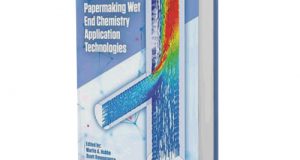SAMANTHA GEIER
In the fall of 2014, TAPPI started a dialogue with the Smithsonian Libraries in Washington, DC to restore three books from our library. The books we chose showed signs of significant deterioration and ranged from more than 150 to 204 years old. The entire restoration process took almost 23 months, after which we donated one of the volumes to the Smithsonian Libraries’ collection.
The Sister Arts, or a Concise and Interesting View of the Nature and History of Paper Making, Printing and Bookbinding – Printed and Published by J. Baxter, 1809
The “after” photos show improved binding and repaired tape damage for The Sister Arts book.
 This book had stained covers, spine damage, sections missing and endsheets and textblock loose at the hinges as well as an illustration page repaired with tape. Restoration included removing the sheepskin spine covering and lining and replacing it with Japanese and Dove Grey archival paper. The tape was removed with a heated tacking iron and the tear was mended with toned Japanese paper and wheat starch paste. A new cover of vegetable-dyed goatskin was attached to the spine and boards and the inside joints were reinforced with Japanese paper and wheat starch paste. Finally, a new enclosure was created to hold the volume.
This book had stained covers, spine damage, sections missing and endsheets and textblock loose at the hinges as well as an illustration page repaired with tape. Restoration included removing the sheepskin spine covering and lining and replacing it with Japanese and Dove Grey archival paper. The tape was removed with a heated tacking iron and the tear was mended with toned Japanese paper and wheat starch paste. A new cover of vegetable-dyed goatskin was attached to the spine and boards and the inside joints were reinforced with Japanese paper and wheat starch paste. Finally, a new enclosure was created to hold the volume.
Historical Account of the Substances Which Have Been Used to Describe Events, and to Convey Ideas, from the Earliest Date to the Invention of Paper — by Matthias Koops, 1891:
Historical Account of the Substances Which Have Been Used to Describe Events, before restoration.
This leather-bound, marbled paper book was sent to the Smithsonian with its spine cover missing and major stains on its cover. The missing spine cover had been taped together and multiple pages were stained and discolored. Restoration included mechanically removing the spine lining using a tacking iron, and ethyl alcohol and deionized water was used to detach the tape and dis-bind the textblock. The textblock pages were washed, deacidified, and flattened under weight and blotter before being resewn using toned linen thread with new endpapers that most closely match the originals. The spine was lined with two layers of Japanese paper, aerolinen, and one layer of Dove Grey archival paper. Finally, a custom enclosure was created to house the book, original boards, and sewing thread.
Chronology of the Origin and Progress of Paper and Paper Making, From 670 B.C. to 1877 A.D. — by J. Munsell, 1864
This cloth-bound book was remitted to the Smithsonian with a loose spine and major stains on its binding as well as damaged endcaps and worn and missing cloth from its edges. The restoration consisted of mechanically removing the spine lining using a poultice of methyl cellulose and separating the textblock from the case. The spine was relined with two layers of Japanese paper and wheat starch paste as well as one layer of Dove Grey archival paper using polyvinyl acetate (PVA) and the textblock was resewn around cord using linen thread. Finally, the original case spine was lined with toned aerolinen and attached to the upper and lower boards with PVA, while a hollow-back spine was constructed using Dove Grey archival paper.
polyvinyl acetate (PVA) and the textblock was resewn around cord using linen thread. Finally, the original case spine was lined with toned aerolinen and attached to the upper and lower boards with PVA, while a hollow-back spine was constructed using Dove Grey archival paper.
Following the completed restorations, TAPPI donated the Historical Account of the Substances Which Have Been Used to Describe Events, and to Convey Ideas, from the Earliest Date to the Invention of Paper to the Smithsonian Libraries. Director of Advancement Christina Muracco said the volume would be “especially wonderful to accompany a rare book in our collection by Jacob Christian Schäffer, (who) is still discussed among paper scholars for his experiments aimed at making paper from a wide variety of natural materials ranging from wasps’ nests to poplar wool to pine cones.”
The remaining restored books are on display in TAPPI’s library. Though a lengthy and tedious process, restoring these treasured pieces of paper history was a project well worth the wait, as it brings a bit of the past into the future.
Congratulations to Chuck Klass
Charles “Chuck” Klass will be inducted into the Paper Industry International Hall of Fame (PIIHF). This induction recognizes Klass as a pioneer of the world’s paper industry. He is one of six 2016 inductees being honored at the Annual Banquet and Induction Ceremony this October.
 Klass has more than five decades of paper industry experience and is recognized as an expert in the development of coated and other value-added papers, processing and use of recycled fiber, and application of innovative technology to the paper industry. He currently serves as adjunct professor of paper engineering at Western Michigan University. Klass is a TAPPI Fellow and received the Gunnar Nicholson Gold Medal Award in 2015.
Klass has more than five decades of paper industry experience and is recognized as an expert in the development of coated and other value-added papers, processing and use of recycled fiber, and application of innovative technology to the paper industry. He currently serves as adjunct professor of paper engineering at Western Michigan University. Klass is a TAPPI Fellow and received the Gunnar Nicholson Gold Medal Award in 2015.
TAPPI congratulates Chuck Klass on this noteworthy achievement and looks forward to his future successes. For more information about PPIHF, visit paperhall.org.
On the Bookshelf:
 Starch and Starch Products in Surface Sizing and Paper Coating
Starch and Starch Products in Surface Sizing and Paper Coating
Authors: G. Gordon Bugg,
Dr. Detlev Glittenberg, Robert L. Kearney, Charles P. Klass, Anthony V. (Tony) Lyons, Stig V. Renvall
Editors: Dr. Hans W. Maurer,
Dr. Detlev Glittenberg
This publication is a comprehensive, updated overview about basic starch chemistry, starch modifications, quality control, shipment, storage, cooking, in-mill conversion, best practice of application in surface sizing and coating, and environmental aspects.
• Every chapter has been reviewed and updated to reflect the latest developments.
• Unique information on the technology not found in any other source.
• Pro and Con explanations of alternative processes.
To view the table of contents and see listing prices, visit www.tappi.org/Bookstore
Left, the original materials in the custom enclosure for preservation; right, the newly-bound Historical Account.
 Paper 360
Paper 360


